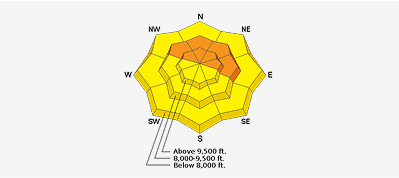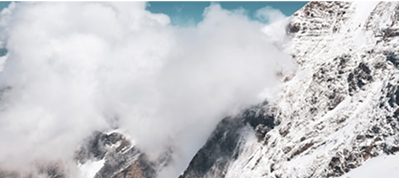A case of the flu has kept me off the snow since last weekend and I was finally able to get out and ride my snowmachine around to look at snow today. It's always important to have a good handle on what the state of the current snowpack is prior to an expected new load. Well, poking around for half a day isn't exactly what I call 'getting a good handle on things' but here's what I found.
There's a nice layer of newer low density snow on the surface. We are anticipating higher density snow with the next storm plus significant wind. The current low density snow on the surface, in theory, could act as a weak layer on it's own once covered with higher density snow especially wind driven snow.
Below this lower density snow lies the layering that will most likely be the active one. It's a layer of near surface facets that formed starting around Thanksgiving up to Dec 11. These facets have been widely identified in observations. So, we know they are present, now we just need the proper load on top to make them fail. Will this happen with the Sunday-Monday storm? Well, the 18z model runs just came in and both the NAM and GFS are still insisting on 2+ inches of water weight plus stout northwest winds. Temperatures will be relatively warm and snow densities high. This should be enough to produce some natural avalanches.
Some more thoughts on the layer of facets in the mid pack. They are present down to at least 9000 feet, probably a bit lower also. Also, I've noted a crust above the facets in many locations. This is somewhat similar to the set up in early November that produced very wide avalanches. However, I don't think the current facets in question are quite as weak as those in early November.
A question is, how much snow will accumulate in the mid elevations (7000-9500')? Perhaps not that much considering the rain-snow level will get up to around 8000'. I suspect the greatest hazard will be above 9000'. That being said, the upper elevations have seen some wind that has stirred up the older facets and created various wind crusts on top of them, some pretty stout. This may make things a bit irregular as some crusts will hold more weight than others prior to failing. See D Jackson's observation from today for thoughts on this also: CARDIFF PEAK AREA
So, what's the BOTTOM LINE on all this rambling? A known weak layer getting loaded with high density snow plus strong winds is enough information to 'stand down' on steep slopes for a number of days. We need to let this storm do it's thing and go out afterward and prowl around to see how the pack reacted. If the storm actually produces what is advertised, we should see avalanches. If we only get an inch or so of water weight, that may not be enough. Either way, we need to have patience and see how things shake out.






